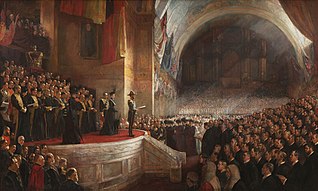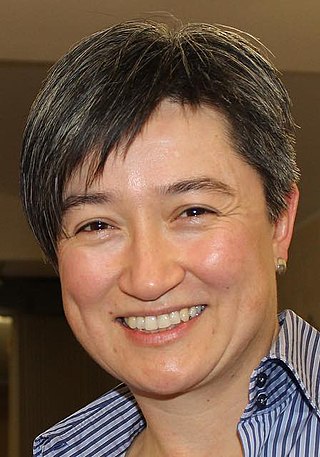Related Research Articles

The prime minister of Australia is the head of government of the Commonwealth of Australia. The prime minister heads the executive branch of the federal government of Australia and is also accountable to federal parliament under the principles of responsible government. The current prime minister is Anthony Albanese of the Australian Labor Party, who became prime minister on 23 May 2022.

The House of Representatives is the lower house of the bicameral Parliament of Australia, the upper house being the Senate. Its composition and powers are established in Chapter I of the Constitution of Australia.

The Parliament of Australia is the legislative branch of the government of Australia. It consists of three elements: the monarch, the Senate and the House of Representatives. The combination of two elected chambers, in which the members of the Senate represent the states and territories while the members of the House represent electoral divisions according to population, is modelled on the United States Congress. Through both chambers, however, there is a fused executive, drawn from the Westminster system.

Parliament House, also referred to as Capital Hill or simply Parliament, is the meeting place of the Parliament of Australia, and the seat of the legislative branch of the Australian Government. Located in Canberra, the Parliament building is situated on the southern apex of the Parliamentary Triangle atop Capital Hill, at the meeting point of Commonwealth, Adelaide, Canberra and Kings Avenue enclosed by the State Circle.

Anthony Michael Byrne is a former Australian politician. A member of the Australian Labor Party in the Australian House of Representatives, he was one of federal parliament's longest-serving members, having first entered Parliament in November 1999, representing the Division of Holt in Victoria. He was forced to resign as the deputy chair of the Parliamentary Joint Committee on Intelligence and Security providing oversight of Australia's security services after he made admissions of corruption and branch-stacking at Victoria's Independent Broad-based Anti-corruption Commission and did not re-contest the subsequent 2022 federal election.

The National Library of Australia (NLA), formerly the Commonwealth National Library and Commonwealth Parliament Library, is the largest reference library in Australia, responsible under the terms of the National Library Act 1960 for "maintaining and developing a national collection of library material, including a comprehensive collection of library material relating to Australia and the Australian people", thus functioning as a national library. It is located in Parkes, Canberra, ACT.
The referendum of 13 April 1910 approved an amendment to the Australian constitution. The referendum was for practical purposes a vote on the Constitution Alteration Bill 1909, which after being approved in the referendum received the Royal Assent on 6 August 1910.
Sir Harold Leslie White was the Parliamentary Librarian of Australia from 1947 to 1960, and National Librarian from 1960 until his retirement in 1970.
The Parliamentary Joint Committee on Intelligence and Security (PJCIS) is a joint committee of the Parliament of Australia which oversees Australia's primary agencies of the Australian Intelligence Community: Australian Security Intelligence Organisation (ASIO), the Australian Secret Intelligence Service (ASIS), the Australian Signals Directorate (ASD), the Defence Intelligence Organisation (DIO), the Australian Geospatial-Intelligence Organisation (DIGO), and the Office of National Assessments (ONA).

The Australian Bureau of Statistics (ABS) is the independent statutory agency of the Australian Government responsible for statistical collection and analysis and for giving evidence-based advice to federal, state and territory governments. The ABS collects and analyses statistics on economic, population, environmental and social issues, publishing many on their website. The ABS also operates the national Census of Population and Housing that occurs every five years.
The Council of Australian University Librarians (CAUL) is a representative leadership body for university libraries in Australia. The CAUL members represent 39 Australian University Institutions and 8 New Zealand University Institutions. Membership is restricted to library directors whose parent institutions are full members of Universities Australia.

The Opening of the First Parliament of the Commonwealth of Australia by H.R.H. The Duke of Cornwall and York, May 9, 1901, more commonly known in Australia as The Big Picture, is a 1903 painting by the Australian artist Tom Roberts. The painting, measuring 304.5 by 509.2 centimetres, or roughly 10 by 17 feet, depicts the opening of the first Parliament of Australia at the Royal Exhibition Building in Melbourne on 9 May 1901.

The Leader of the Government in the Senate is the government's most senior cabinet minister in the Australian Senate and the main government spokesperson in the Senate. His or her Opposition counterpart is the Leader of the Opposition in the Senate.
The Leader of the Opposition in the Senate is a party office held by the Opposition's most senior member of the Shadow Cabinet in the Australian Senate, elected to lead the opposition party in the body. Though the leader in the Senate does not have the power of the office of Leader of the Opposition, there are some parallels between the latter's status in the lower house and the former's in the Senate. In addition to his or her own shadow ministerial portfolio, the leader has overarching responsibility for all policy areas and acts as the opposition's principal spokesperson in the upper house. The leader is entitled to sit at the table of the Senate, and has priority in gaining recognition from the President of the Senate to speak in debate. Another similarity is that the leader typically announces changes to opposition officeholders in the Senate, including shadow ministers, party leadership and whips. The leader also has some responsibility for appointing opposition senators to committees, a role filled by the Manager of Opposition Business and whips in the lower house. The current leader is Simon Birmingham. He is assisted by a Deputy Leader of the Opposition in the Senate, currently Michaelia Cash.
In the Parliament of Australia, the political parties appoint party whips to ensure party discipline, help manage legislative business and carry out a variety of other functions on behalf of the party leadership. Additional functions of the government party whips is to ensure that a sufficient number of government members and senators are present in the chamber to ensure passage of government legislation and measures and to prevent censure motions succeeding, and to ensure presence of a parliamentary quorum. Their roles in the chamber include tally votes during divisions, and arranging pairs which affects the ability of members and senators to leave parliament during sittings, as well as the entitlement to be absent during divisions.
Michael John Brudenall was an Australian librarian and library educator. He contributed to the development of library technician education and employment in Australia. He planned the Commonwealth Parliamentary Library for the new Parliament House building in Canberra and advocated for stronger collaboration between the parliamentary libraries in the Asia Pacific region.

The High Commissioner of Australia to Sri Lanka is an officer of the Australian Department of Foreign Affairs and Trade and the head of the High Commission of the Commonwealth of Australia to the Democratic Socialist Republic of Sri Lanka in Colombo. The High Commissioner has the rank and status of an Ambassador Extraordinary and Plenipotentiary and is currently David Holly, who also holds non-resident accreditation as High Commissioner to the Maldives.

Christopher John Crewther is an Australian politician. He was a Liberal Party of Australia member of the Australian House of Representatives from 2016 to 2019 before being elected to the Victorian State Parliament, representing the division of Mornington in 2022.

David Philip Benedict Smith is an Australian politician. On 23 May 2018, the High Court of Australia declared him elected as a Senator for the Australian Capital Territory after Labor senator Katy Gallagher was found ineligible to have been elected. Before his election, Smith was the ACT director of the Professionals Australia union. He was sworn in to the Australian Senate on 18 June 2018. He was elected to the lower-house seat of Bean at the 2019 federal election.

This is a list of members of the House of Representatives of the 46th Parliament of Australia (2019–2022).
References
- ↑ "PARLIAMENTARY LIBRARY". The Age . No. 14, 478. Victoria, Australia. 1 August 1901. p. 6. Retrieved 30 May 2016.
- ↑ "THE PARLIAMENTARY LIBRARY". The Age . No. 14, 473. Victoria, Australia. 26 July 1901. p. 5. Retrieved 30 May 2016.
- 1 2 "Commonwealth Parliament Library (Australia) – Libraries Australia Search". nla.gov.au. Retrieved 23 May 2016.
- ↑ "The National Library of Australia Storehouse of knowledge". The Canberra Times . Vol. 42, no. 12, 080. Australian Capital Territory, Australia. 15 August 1968. p. 27. Retrieved 23 May 2016.
- ↑ "Sir Harold still watching over his library". The Canberra Times . Vol. 58, no. 17, 590. Australian Capital Territory, Australia. 26 November 1983. p. 10. Retrieved 23 May 2016.
- ↑ "Commonwealth Parliament Library (Australia). – People and organisations". Trove. Retrieved 23 May 2016.
- ↑ "About the Parliamentary Library". aph.gov.au. Retrieved 23 May 2016.
- ↑ "THE FIRST 100,000". The Canberra Times . Vol. 41, no. 11, 633. Australian Capital Territory, Australia. 10 March 1967. p. 32. Retrieved 23 May 2016.
- ↑ "Department of Parliamentary Services". Parliament of Australia. 14 October 2019. Retrieved 30 May 2020.
- ↑ . CC BY 3.0 AU licence. "Annual Report 2018–19". Annual Report. Parliament of Australia. Dept of Parliamentary Services. ISSN 1832-0848 . Retrieved 30 May 2020.
{{cite journal}}: CS1 maint: others (link) - ↑ "Organisational Senior Staff". Parliament of Australia. 22 April 2020. Retrieved 30 May 2020.
- ↑ "The Parliamentary Librarian". Parliament of Australia. 1 February 2018. Retrieved 30 May 2020.
- ↑ "Part 4 The Parliamentary Library". aph.gov.au. Retrieved 23 May 2016.